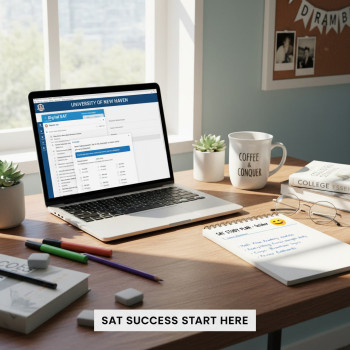Why Procrastination Happens — and Why It’s Not Your Fault
If you’ve ever promised yourself “I’ll start studying tomorrow” and then spent the evening doom-scrolling instead, welcome to a crowd that includes high-achievers, overworked students, and people who genuinely want to do better. Procrastination isn’t laziness. It’s a predictable human response to tasks that feel big, uncertain, or emotionally uncomfortable. Preparing for the Digital SAT fits that description: the test feels important, the material is broad, and it’s easy to worry about not doing it “right.”
Understanding what’s really going on — fear of failure, perfectionism, unclear goals, decision fatigue — is the first step. Once you stop beating yourself up and start diagnosing, you can put practical tools in place to change the pattern.
Mindset Shifts That Make Procrastination Easier to Beat
1. Replace the all-or-nothing voice with a kind, practical one
Perfectionist self-talk like “I must study for three hours or it won’t count” often leads to doing nothing. Swap that for a kinder, realistic prompt: “I’ll do 25 focused minutes now and it will help me build momentum.” Small, consistent wins beat occasional marathon sessions.
2. Focus on the process instead of the outcome
Thinking only about your target score creates anxiety. Instead, celebrate process goals: completing practice passages, learning five new math techniques this week, or sticking to a study block for five consecutive days. Process goals are controllable, measurable, and habit-forming.
3. Reframe discomfort as growth
When you feel resistance to studying, label it: “That’s my brain signaling discomfort; it’s part of learning.” Naming the feeling reduces its power and helps you act despite it.
Practical Systems to Turn “I’ll Do It Later” into “I Did It Today”
1. Use tiny habits to get started
The hardest part is usually the start. Commit to ridiculously small study actions that are hard to resist: 10 minutes of reading a passage, one math problem, or opening the official practice test interface. Ten minutes often turns into 30 or more once you’re in flow.
2. Time-block like a pro: Pomodoro and variations
Structured time blocks reduce decision fatigue and create urgency. The classic Pomodoro is 25 minutes focused, 5 minutes break. For SAT studying, you might prefer 50/10 for deeper concentration or a micro-Pomodoro of 15/3 when motivation is low. Experiment and keep what works.
3. Make your study plan visible
Put a one-page study plan where you see it — on your desk, phone background, or calendar. A visible plan reduces the daily decision burden. It’s easier to start when the next steps are unambiguous.
4. Chunk big goals into micro-goals
Instead of “improve writing score,” write: “This week: do two timed Writing & Language sections and review mistakes; learn three grammar rules I missed.” Micro-goals are measurable and encourage continuous progress.
Designing a Realistic SAT Study Schedule (that you’ll actually follow)
Below is a practical template for different time-availability scenarios. Each plan balances content review, timed practice, error analysis, and rest. Pick the variant that fits your life and adapt weekly.
| Available Time | Weekly Structure | Key Focus |
|---|---|---|
| 30–60 min/day (4–5 days/wk) |
|
Consistency, small habit wins, question-level practice |
| 1–2 hours/day (5–6 days/wk) |
|
Skill building, pacing, timed practice |
| 3+ hours/day (intensive) |
|
Deep practice, diagnostic improvements, error patterns |
Remember: regular short sessions usually beat infrequent long sessions. The brain needs spaced repetition to retain concepts, and the Digital SAT rewards steady practice and familiarity with adaptive testing formats.
Daily Rituals That Defeat Procrastination
Morning 10-Minute Launch
Start the day with a 10-minute SAT micro-session: a reading passage or a couple of math problems. This creates momentum and makes the rest of the day feel productive.
End-of-Day Reflection (5–10 minutes)
Briefly review what you learned, list two wins, and note one thing to improve tomorrow. This ritual builds forward motion and dissolves the temptation to “start fresh” tomorrow because progress is recorded.
Accountability anchors
Tell someone — a friend, parent, or tutor — what you’ll do today. Accountability works because human beings are social creatures; knowing someone will check in raises the cost of skipping a session.
Tools and Techniques to Stay Focused
1. Use a “temptation bundling” strategy
Pair something you enjoy with studying: only listen to your favorite playlist while doing practice sections or allow a snack you love after a completed study block. This links short-term pleasure to productive behavior.
2. Create a distraction-free environment
Put your phone in another room or use focus apps that block notifications. Clear the study space of unrelated clutter. Environmental friction — making distractions just a bit harder — reduces impulse checking.
3. Track progress visually
Use a simple checklist or streak calendar. Crossing off days builds a mini-reward loop; the streak itself becomes motivating.
Study Strategy Examples (Real-World, Not Theoretical)
Below are concrete examples showing how students can apply the above systems in everyday situations.
Example 1 — Busy junior balancing sports and school
- When: 6:30–7:00 AM before practice
- What: 25-minute Reading practice (Pomodoro), 5-minute review of mistakes
- Why it works: Consistent short sessions fit a busy schedule and build reliability.
Example 2 — Senior with college apps looming
- When: Two 75-minute evening sessions (content + timed practice)
- What: Focused math concept for 45 minutes; one timed Writing & Language section the next evening
- Why it works: Prioritizes targeted weakness repair while maintaining test familiarity.
Example 3 — Student who stalls because practice tests feel demoralizing
- Strategy: Start with diagnostic mini-tests (one section). Then study one type of error (e.g., algebra errors) for a week and re-test.
- Why it works: Smaller, frequent wins restore confidence and reduce avoidance.
How to Learn From Mistakes Without Getting Discouraged
Errors are gold. They reveal patterns — not failures. Treat each mistake like a data point. Create an “errors journal” with three columns: Question type, Mistake cause, Fix to practice. After two weeks, scan for patterns. Are most errors careless? Do they come from weak algebra skills or reading comprehension speed? Your study plan should target the most frequent, high-impact error types first.
Why Digital SAT Familiarity Reduces Procrastination
The Digital SAT’s format introduces new navigation, timing, and adaptive elements. Anxiety about test format is a major contributor to avoidance. Simulate test conditions: use the official practice interface, practice with the Bluebook app or digital practice tests, and do entire sections in one sitting. Familiarity reduces the fear factor and makes practice feel like preparation, not a risk.
Sample 8-Week Roadmap to Reduce Procrastination and Improve Score
This roadmap assumes a steady pace for students who can study 5–7 hours a week. It focuses on habit formation and gradual ramp-up of test conditions.
| Week | Primary Goal | Weekly Tasks |
|---|---|---|
| 1 | Start the habit |
|
| 2 | Build momentum |
|
| 3–4 | Target weaknesses |
|
| 5–6 | Increase test stamina |
|
| 7–8 | Polish and simulate |
|
The Role of Support — When to Ask for Help
Accountability can be a gentle nudge or a professional boost. If procrastination persists despite good systems, consider structured help: a study partner, a teacher, or personalized tutoring. Targeted, 1-on-1 guidance helps in two ways: it clarifies what to do next (reducing decision paralysis) and creates external deadlines that make skipping harder.
For students who prefer guided accountability, Sparkl’s personalized tutoring offers 1-on-1 guidance, tailored study plans, expert tutors, and AI-driven insights to target weaknesses faster. When used selectively — for diagnostics, weekly check-ins, or pacing strategy — such support can convert stalled intention into steady progress.
Common Roadblocks and Quick Fixes
- Roadblock: “I feel overwhelmed by everything I don’t know.”
Fix: Narrow your focus to two high-impact areas this week. Mastery in a few places yields big gains. - Roadblock: “Practice tests are demoralizing.”
Fix: Start with single sections and gradually increase to full tests. Use a growth mindset and track smallest wins. - Roadblock: “I’m too tired after school.”
Fix: Try short morning sessions or 15-minute review windows after dinner. Quality beats duration.
Measuring Progress Without Obsessing
Track the right things: time spent, types of practice completed, and recurring errors. Occasionally take a full timed digital practice test to see real score trends, but don’t treat every fluctuation as a crisis. Scores move gradually; consistent habits compound. Celebrate process milestones — a full week of study streaks, mastering a question type, or shaving 30 seconds off pacing in a section.
When Motivation Wanes: Rituals That Reignite It
Motivation comes and goes. When yours dips, try these rituals:
- Change location — a new environment often refreshes focus.
- Short accountability call — 10 minutes with a friend or tutor to outline the day’s plan.
- Micro-goal reward — a short walk, a snack, or 20 minutes of a favorite show after hitting a study target.
- Revisit your “why” — write one paragraph about why the SAT matters for your college goals and read it before you study.
Final Thoughts: Consistency Trumps Intensity
Beating procrastination is less about willpower and more about design. Build systems that reduce friction, create tiny, achievable starts, and protect your most productive time blocks. Make studying predictable and kind rather than punishing. With steady momentum, the Digital SAT becomes less of a looming test and more of a milestone you’re prepared to meet.
And remember: asking for help is a strength, not a concession. Personalized tutoring — with targeted practice plans, expert feedback, and accountability — can be the nudge that turns good intentions into real progress. Use support where it fits your study rhythm and keep the focus on sustainable habits. You’ve got this.
Quick Starter Checklist (Do this today)
- Pick one small study action (10–25 minutes) and do it now.
- Create a one-page visible plan for the week with micro-goals.
- Set a practice test date two weeks from now and add it to your calendar.
- Choose an accountability partner or schedule one check-in with a tutor.
Start with one small step. It’s the most powerful way to change a habit. When you look back in a month, you’ll be surprised how far those tiny steps carry you.













No Comments
Leave a comment Cancel